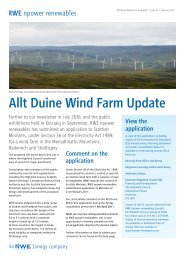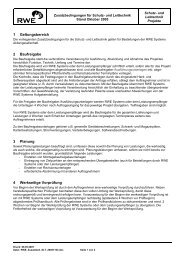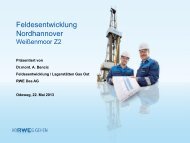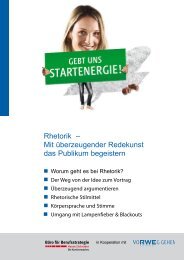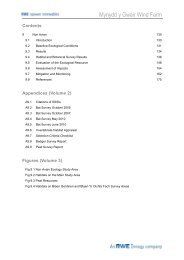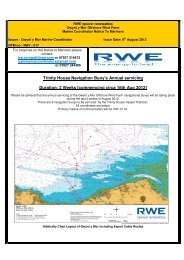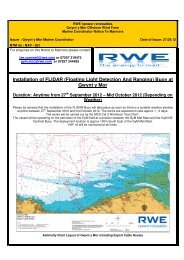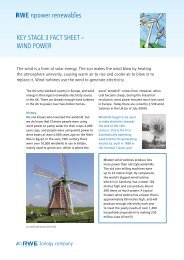F. Geology & Hydrology ( PDF | 31.0 MB ) - RWE.com
F. Geology & Hydrology ( PDF | 31.0 MB ) - RWE.com
F. Geology & Hydrology ( PDF | 31.0 MB ) - RWE.com
You also want an ePaper? Increase the reach of your titles
YUMPU automatically turns print PDFs into web optimized ePapers that Google loves.
that these are 'climate-proofed' for the life of the windfarm. A methodology for quantifying<br />
carbon loss (and any carbon gain resulting from habitat mitigation) was published by the !<br />
Calculating Carbon Savings from Wind Farms on Scottish Peat Lands - A new Approach.<br />
Scottish<br />
Wales.<br />
Executive, Government June (Nayak, 2008.). D.R., ThisMiller, processD., should Nolan, be A., undertaken Smith P. for& all Smith applications J. (2008). in \<br />
Development on and around peat has the potential to cause direct damage through disturbance<br />
or indirect damage through the effects of changes to hydrology. This may lead leading to<br />
drainage and drying out which would allow the peat to oxidise and decay.<br />
We are developing some general guidance for assessing the impact of windfarm<br />
developments on peatland habitats in Wales and will send a copy of this to you when details<br />
have been finalised. In the mean time we would advise that the EIA should be based on any<br />
existing information, such as Cranfield University's national soils data, with a further<br />
<strong>com</strong>prehensive survey concerning the extent, depth and condition of peat deposits across the<br />
site. Peat depth maps showing the extent and depth of peat deposits should be produced so<br />
that they can overlay Phase 1 habitat survey maps. We recognise that there is uncertainty as to<br />
how some of these issues are best investigated and their impacts quantified. We would<br />
therefore wel<strong>com</strong>e the opportunity to discuss this with if necessary.<br />
In general, we would expect that disturbance and/or destruction of peat would be avoided as<br />
far as possible, and where it was not possible, such impacts would be minimised. We would<br />
also re<strong>com</strong>mend that opportunities to halt the deterioration of existing degraded peat and/or to<br />
restore active peat forming vegetation are exploited as part of a strategic environmental<br />
management plan for the site.<br />
We would also draw to your attention that mire habitats are also likely to be encountered<br />
within the proposed development area.<br />
Fauna<br />
With regard to specific species, in addition to those mentioned clarify and to survey methods<br />
proposed we would add:<br />
Red Squirrels - We consider that the main issue here is not where the squirrels are, but<br />
understanding the impact the turbines will have on the viability of the population taking into<br />
account cumulative impacts over the longer term and also the impact on connectivity across<br />
the site.<br />
Pine marten - the Vincent Wildlife Trust Survey (please contact CCW for further details)<br />
didn't identify any positive scats at this location, but wasn't undertaken in ideal conditions and<br />
therefore is not definitive. We therefore re<strong>com</strong>mend that surveyors of this site collect any<br />
likely scats and, if necessary to give adequate site coverage, undertake transects specifically<br />
for such scats, so that they can be identified by DNA analysis.<br />
Common Toad - No reference is made to this species but is needs to be considered in the ES.<br />
Reptiles - Their presence is a material planning issue. We therefore suggest that the scope of<br />
the ES includes assessments of reptile species likely to be affected.<br />
Water voles - We can confirm that we are aware of upland water vole populations within and<br />
in the environs of Clocaenog.<br />
Badgers - Sett and bait marking surveys will be required.




